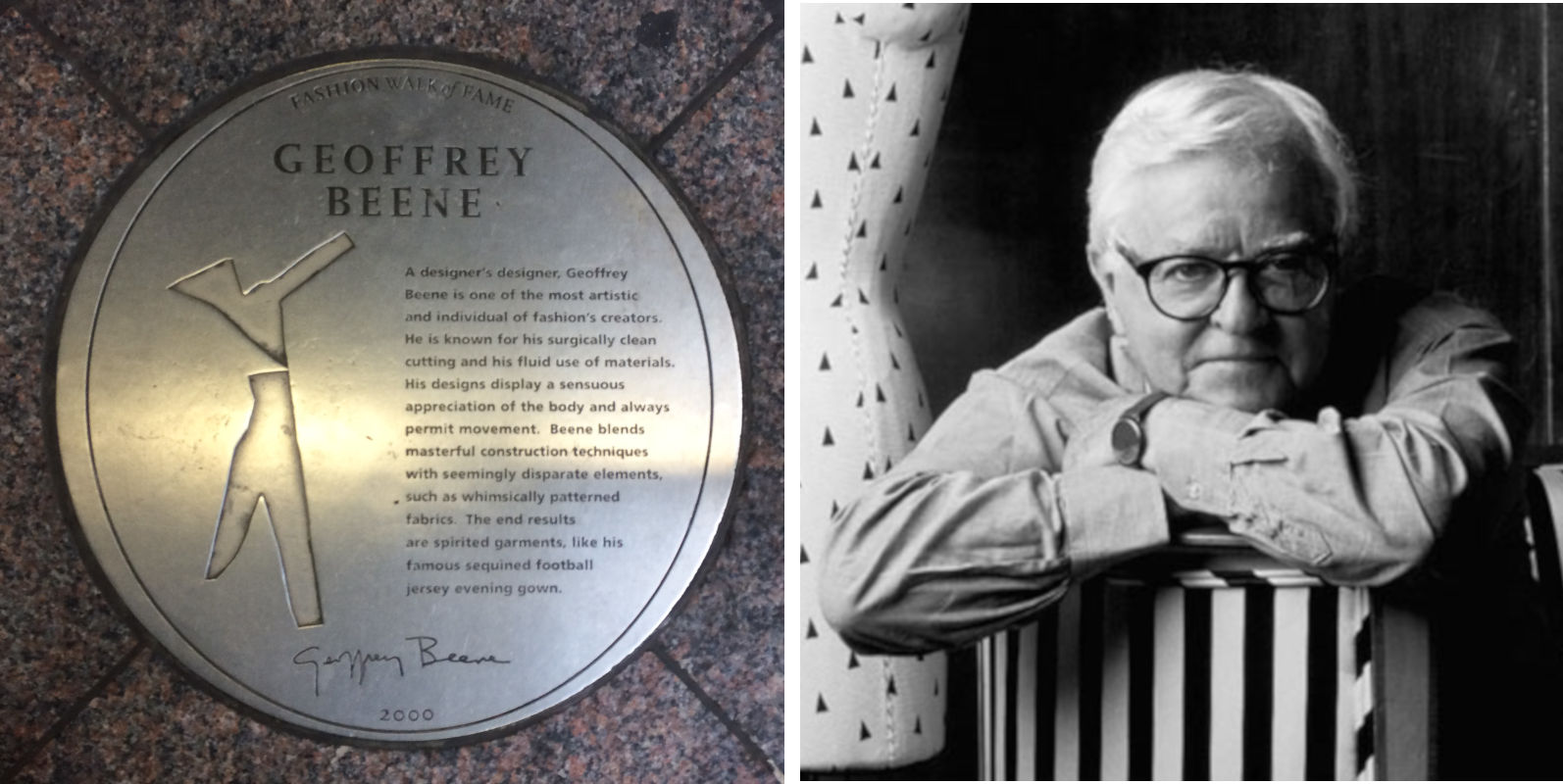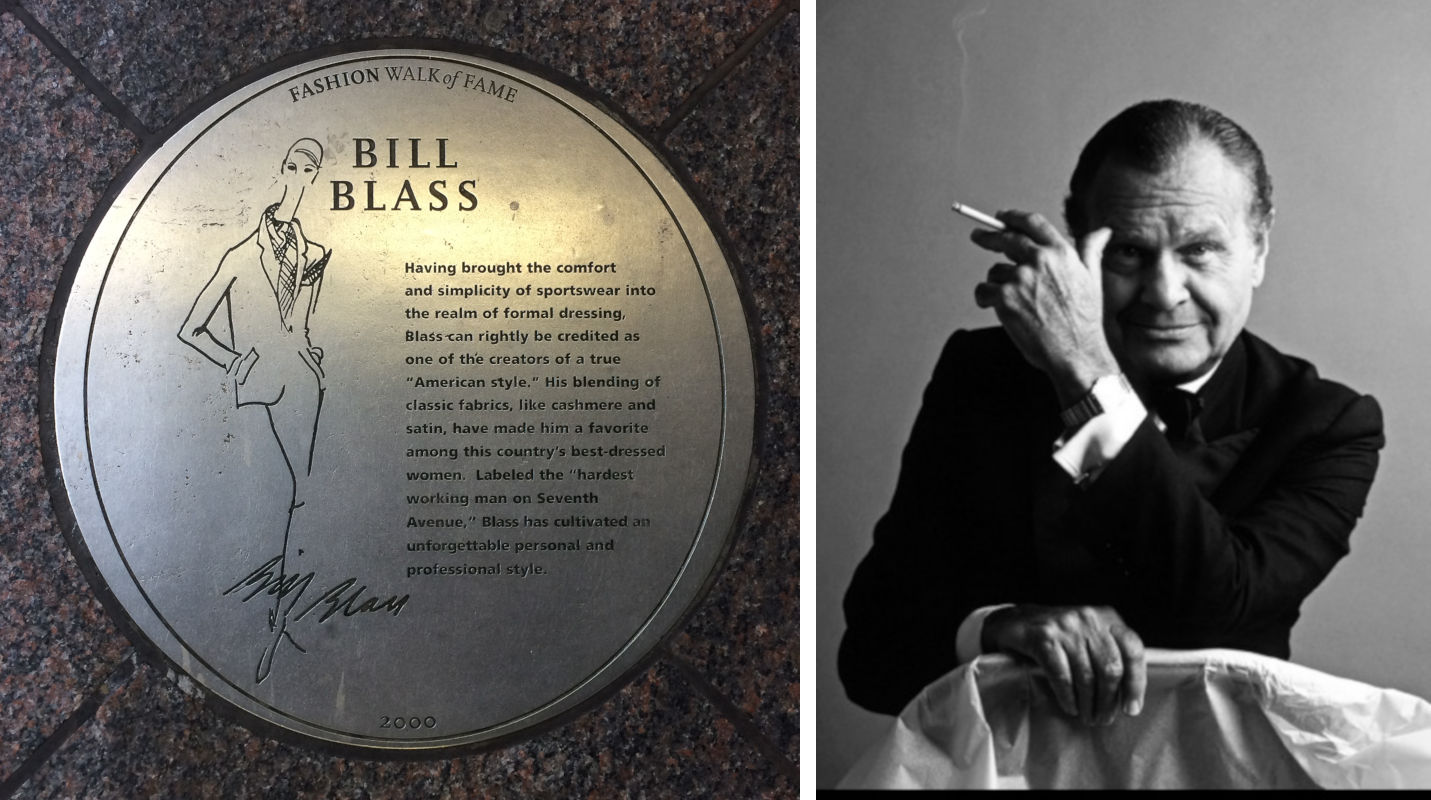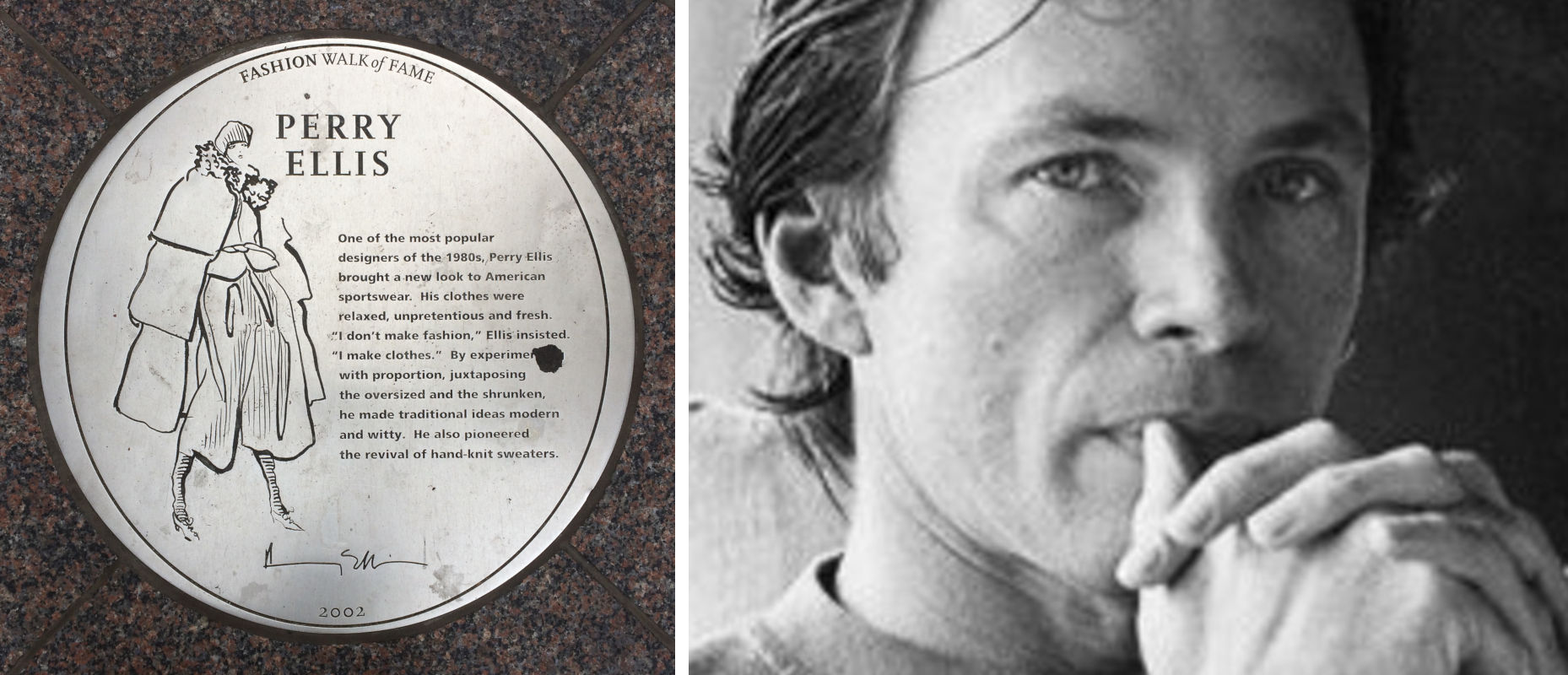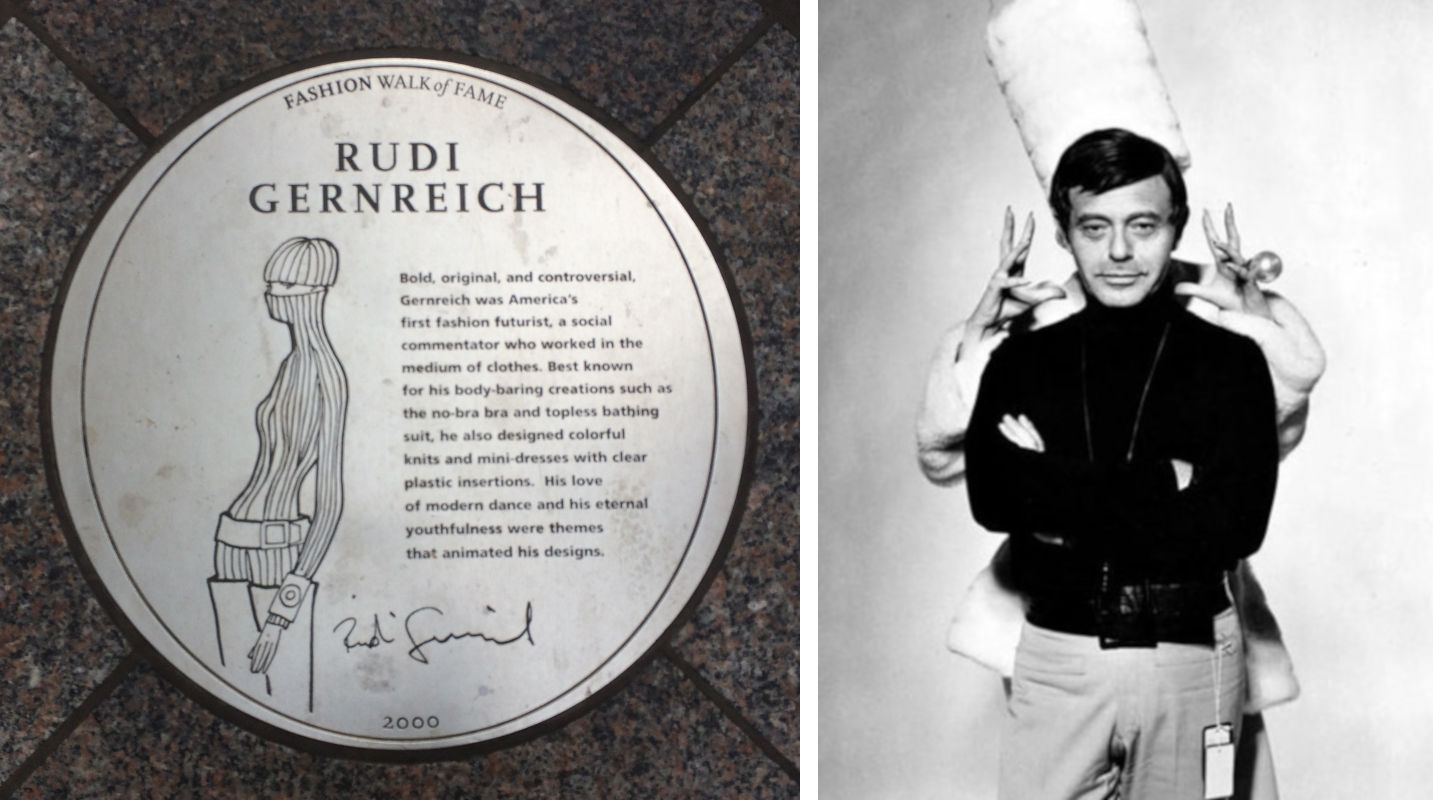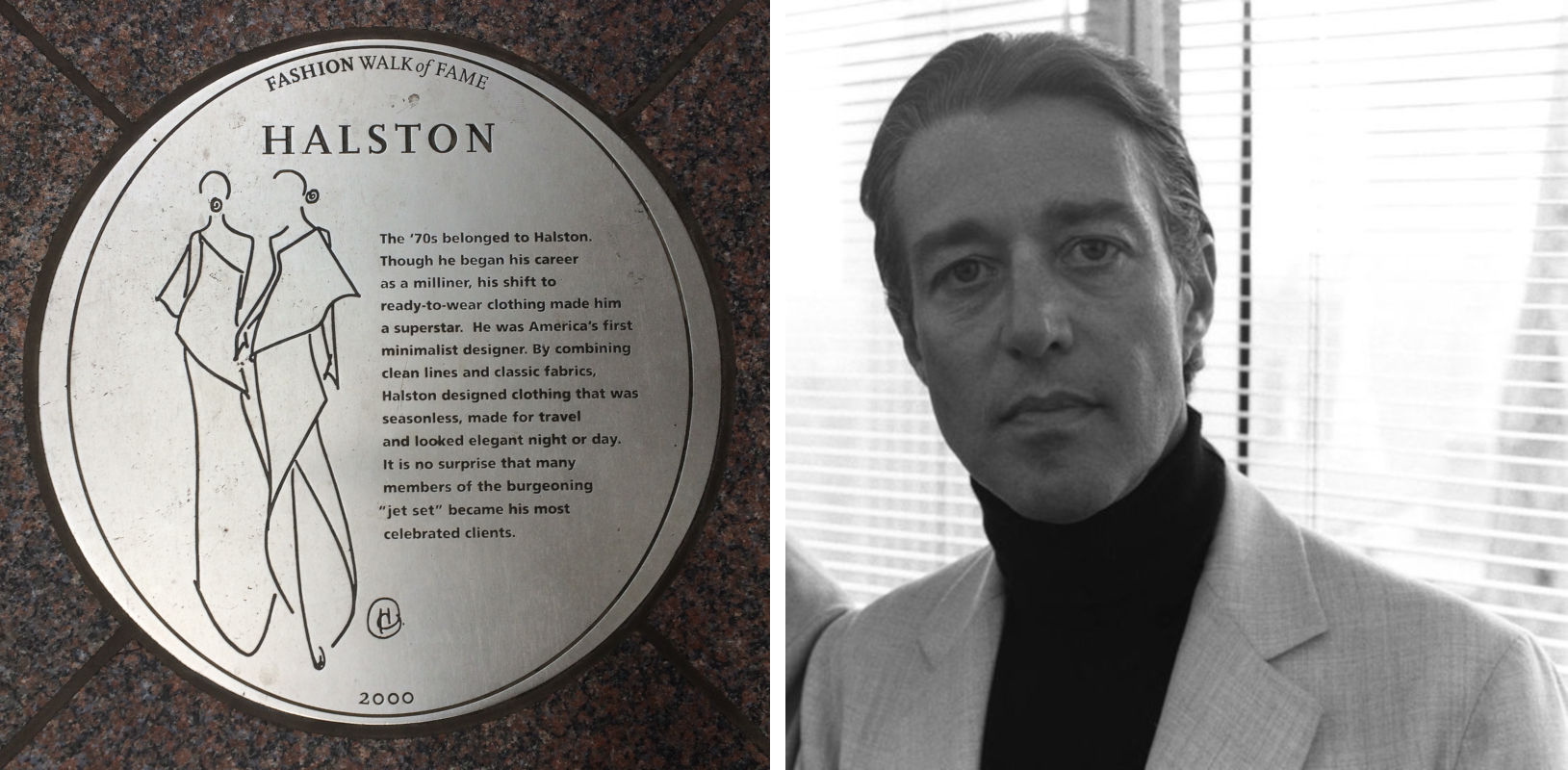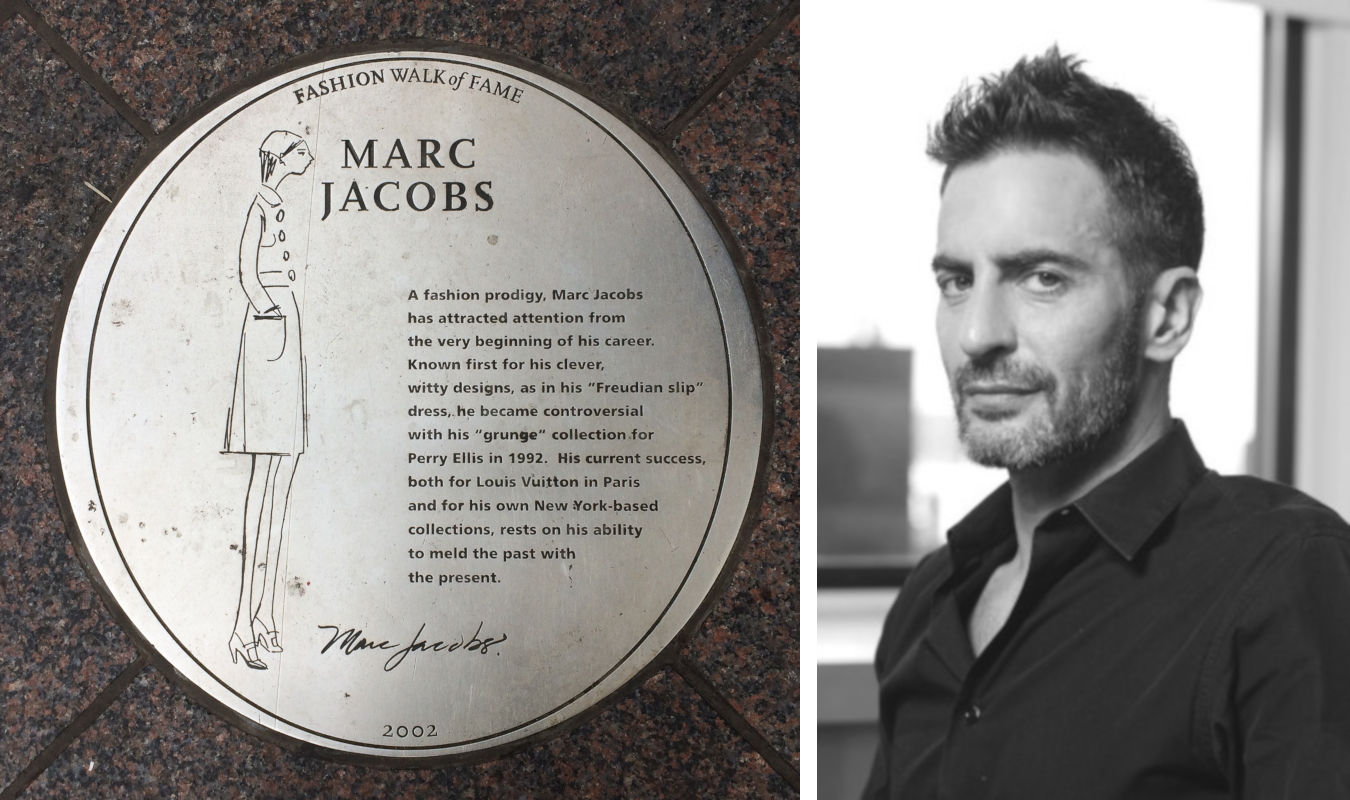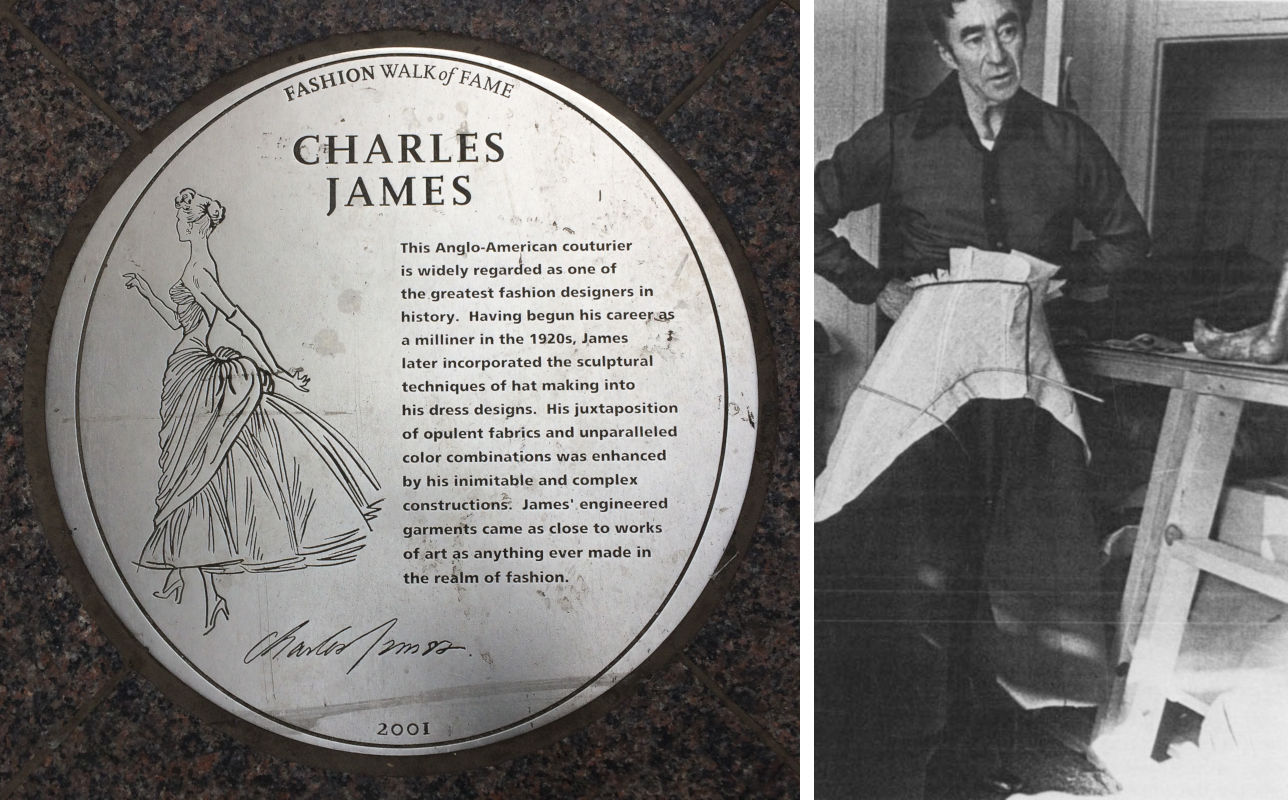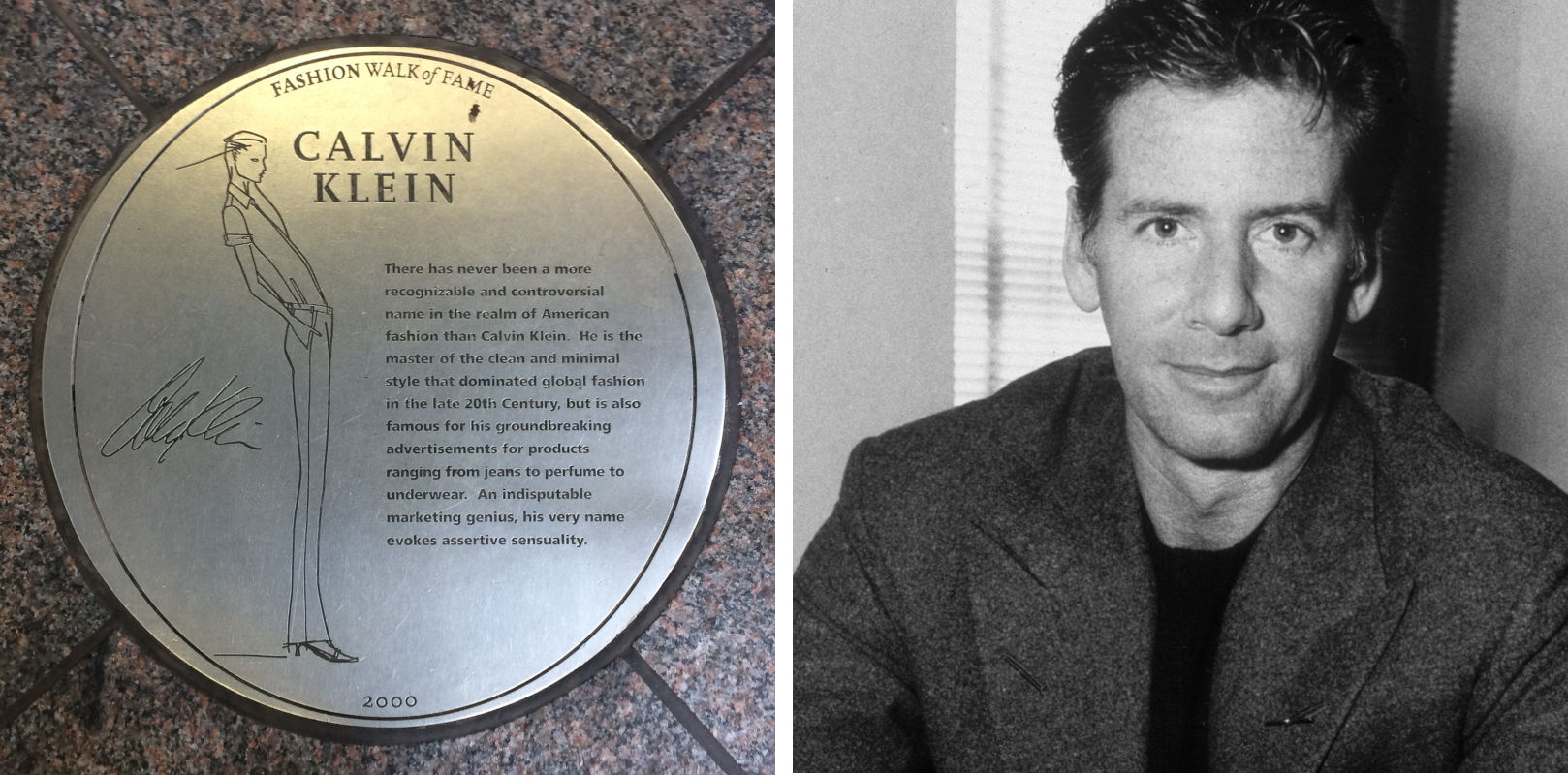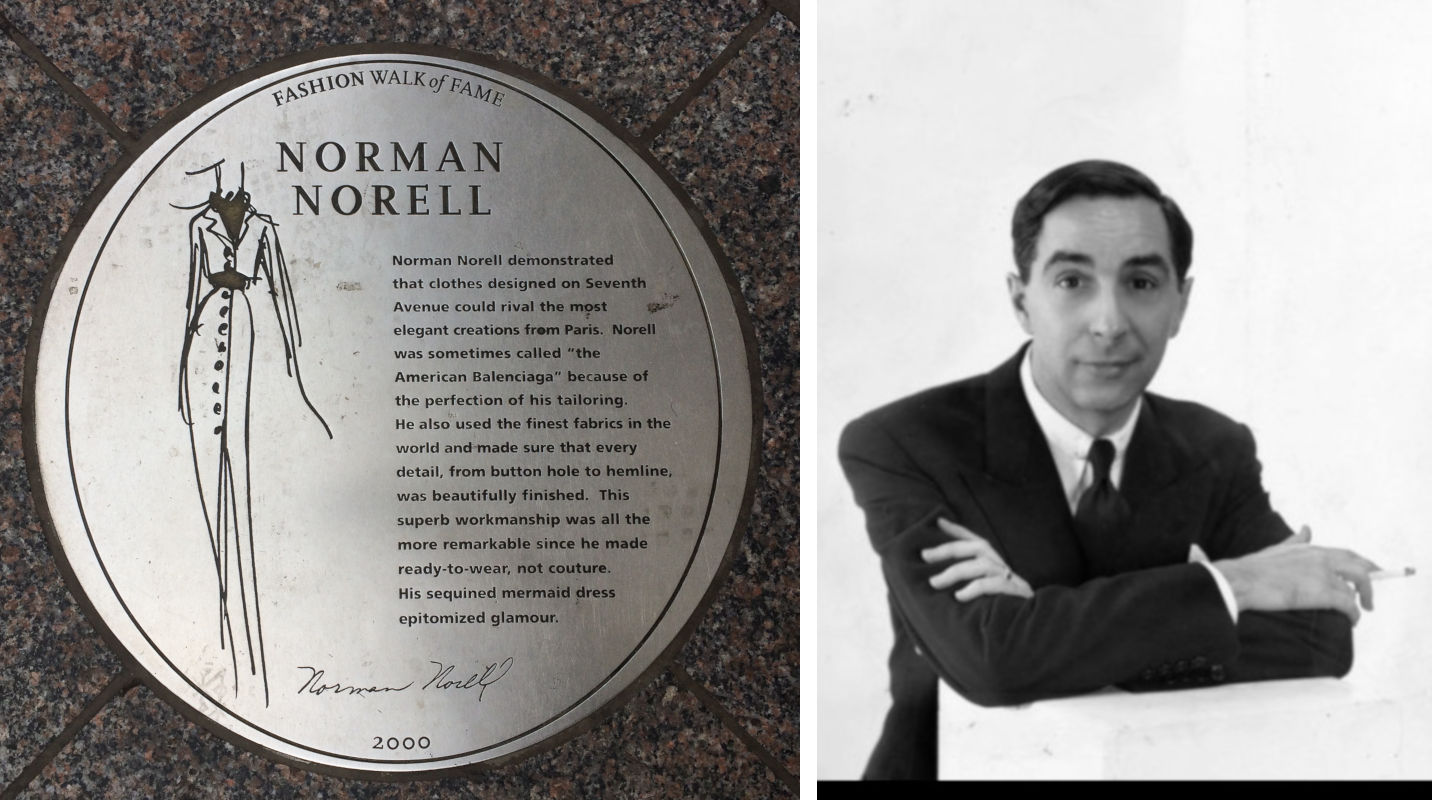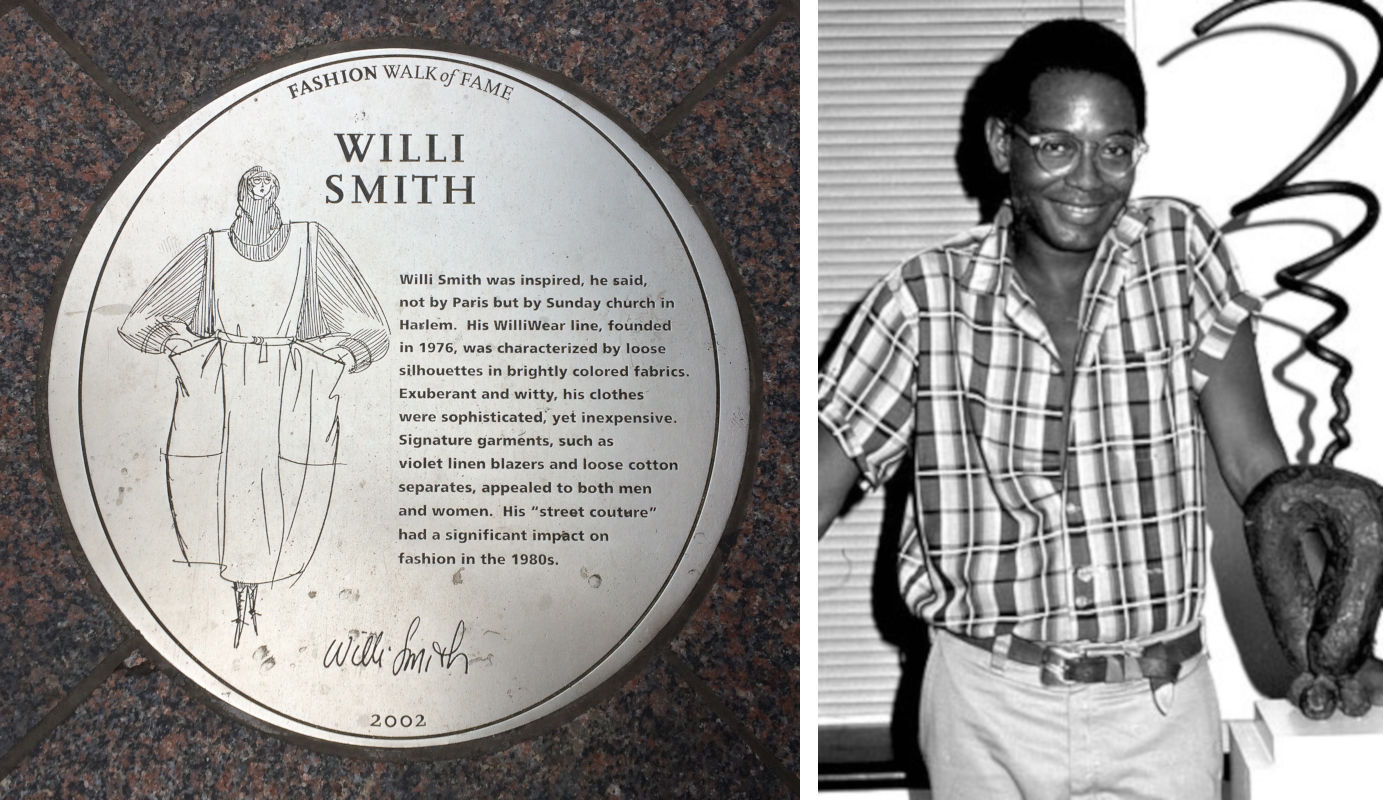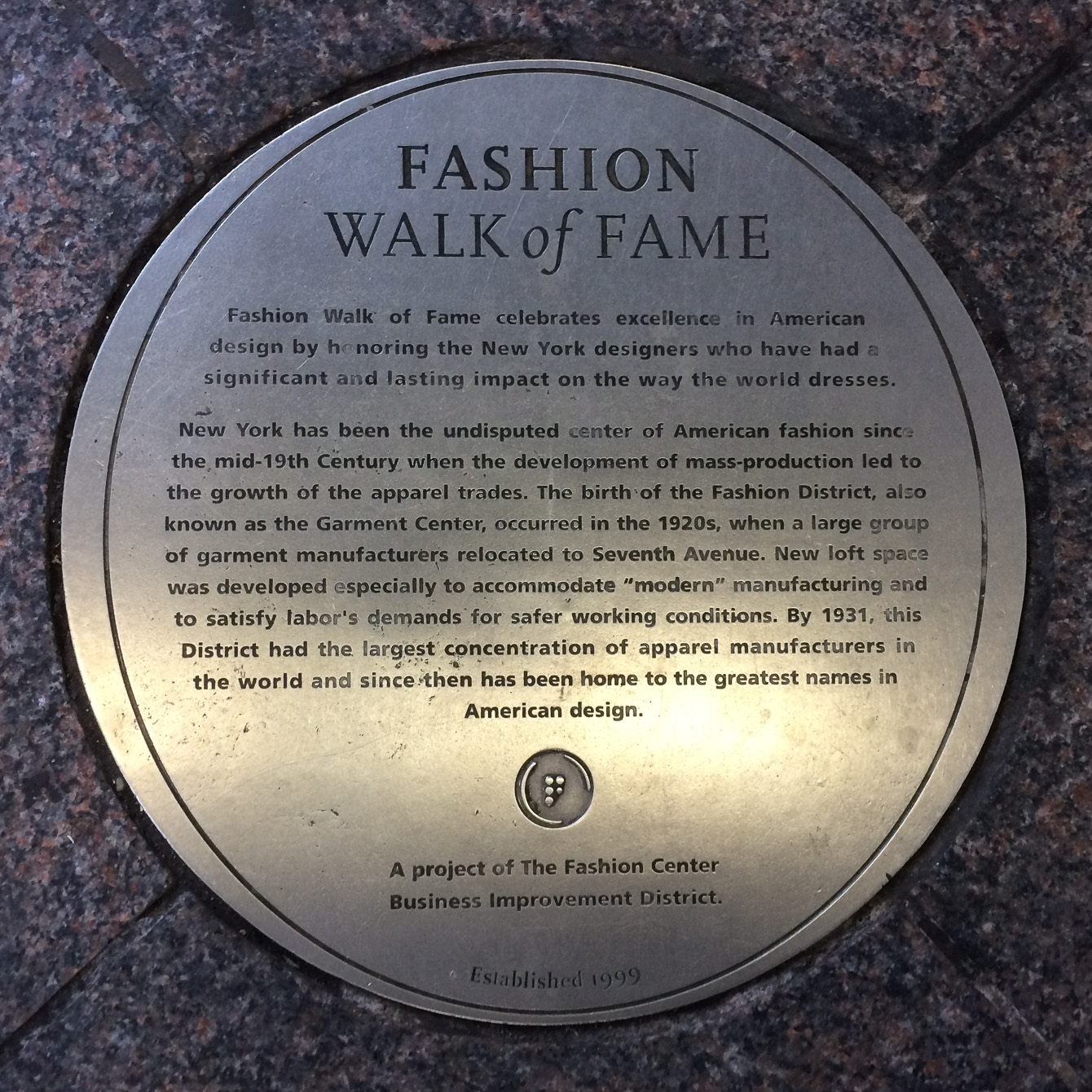
Fashion Walk of Fame
overview
Beginning in the year 2000, plaques have been installed along Seventh Avenue — a corridor synonymous with the fashion industry — to commemorate internationally renowned fashion designers.
Gay fashion designers recognized along the Fashion Walk of Fame include Geoffrey Beene, Bill Blass, Perry Ellis, Rudi Gernreich, Halston, Marc Jacobs, Charles James, Calvin Klein, Norman Norell, and Willi Smith.
History
In the 1920s, New York City’s garment industry moved north to the Seventh Avenue area (the present-day Garment District), becoming a center for garment manufacturing and fashion showrooms. The term “Seventh Avenue” later became synonymous with fashion, especially as so many internationally-renowned fashion designers opened showrooms there. In tribute to “New York designers who have had a significant and lasting impact on the way the world dresses,” the Fashion Center Business Improvement District (BID) established the Fashion Walk of Fame in 1999. The first bronze plaques were installed in 2000. Today, the Fashion Walk of Fame has grown to include plaques located on the sidewalks between West 35th and 41st Streets on the east side of Seventh Avenue. Several gay fashion designers are commemorated there:
Geoffrey Beene (1924-2004) opened his Manhattan fashion house on Seventh Avenue in 1963. His clients included First Ladies Lady Bird Johnson, Pat Nixon, and Nancy Reagan and actresses Faye Dunaway and Glenn Close. In 1976, he became the first American designer to show a collection in Milan, Italy. He later created garments in support of AIDS awareness campaigns. Throughout his illustrious career, Beene won the prestigious Coty American Fashion Critics’ Award eight times and, in 1984, the Council of Fashion Designers of America named the annual Geoffrey Beene Lifetime Achievement award in his honor, which he won in 1997.
In 2000, Beene was part of the inaugural group of designers to receive plaques on the Fashion Walk of Fame. His plaque, located between 39th and 40th Streets, reads: “A designer’s designer, Geoffrey Beene is one of the most artistic and individual of fashion’s creators. He is known for his surgically clean cutting and his fluid use of materials. His designs display a sensuous appreciation of the body and always permit movement. Beene blends masterful construction techniques with seemingly disparate elements, such as whimsically patterned fabrics. The end results are spirited garments, like his famous sequined football jersey evening gown.”
Bill Blass (1922-2002) began working in the New York City fashion world in 1945, eventually founding his own fashion house in 1970. Clients included Happy Rockefeller, Brooke Astor, Nancy Kissinger, Jessye Norman, Gloria Vanderbilt, and Patricia Buckley. Blass won the prestigious Coty Awards three times and received the Council of Fashion Designers of America’s Lifetime Achievement Award in 1987. Although Blass remained private about his sexuality, he noted in his memoir that he enjoyed “absolute freedom” in the army during World War II, yet “After the war, there was no choice. I would always feel more comfortable in a heterosexual world than a homosexual one.”
In 2000, Blass was part of the inaugural group of designers to receive plaques on the Fashion Walk of Fame. His plaque, located between 39th and 40th Streets, reads: “Having brought the comfort and simplicity of sportswear into the realm of formal dressing, Blass can rightly be credited as one of the creators of a true “American style.” His blending of classic fabrics, like cashmere and satin, have made him a favorite among this country’s best-dressed women. Labeled the ‘hardest working man on Seventh Avenue,’ Blass has cultivated an unforgettable personal and professional style.”
Stephen Burrows (b. 1943) was born in Newark, New Jersey, and graduated from the Fashion Institute of Technology in 1966. Four years later, he opened a boutique, Stephen Burrows’ World, at Henri Bendel. Burrows is the first African American fashion designer to achieve international acclaim and to receive the Coty Award, in 1973 (he won again in 1977 and earned a special award for lingerie in 1974). His clothes have been worn by such notable women as Barbra Streisand, Liza Minnelli, Diana Ross, Cher, and former First Lady Michelle Obama.
In 2002, Burrows received a plaque on the Fashion Walk of Fame. His plaque, located between West 40th and 41st Streets, reads: “Stephen Burrows, best known for fluid, body-conscious clothes in bold colors, ‘stretches a rainbow over the body,’ said one admirer. In 1970, he opened a boutique called Stephen Burrows’ World at Henri Bendel, where he sold his famous jersey dresses with rippled ‘lettuce’ hems. Other trademarks include bold color blocking, decorative stitching, and innovative styles in suede and feather. Burrows’ vivacious clothes were featured in the 1973 epochal American fashion show at Versailles.”
Perry Ellis (1940-1986) founded his own fashion house on Seventh Avenue in 1978, two years after releasing his first women’s sportswear line. In a career that spanned less than a decade — due to his untimely death from AIDS-related complications at age 46 — Ellis won ten Coty Awards and, in 1982, the Council of Fashion Designers of America (CFDA) Designer of the Year Award. He became the President of the CFDA two years later. Laughlin Barker, his long-term partner who he lived with in Manhattan, was the chairman of Ellis’ company and is credited with helping to expand its licenses. Barker also died of an AIDS-related illness, a few months before Ellis.
In 2002, Ellis received a plaque on the Fashion Walk of Fame. His plaque, located between 37th and 38th Streets, reads: “One of the most popular designers of the 1980s, Perry Ellis brought a new look to American sportswear. His clothes were relaxed, unpretentious and fresh. ‘I don’t make fashion,’ Ellis insisted. ‘I make clothes.’ By experimenting with proportion, juxtaposing the oversized and the shrunken, he made traditional ideas modern and witty. He also pioneered the revival of hand-knit sweaters.”
Rudi Gernreich (1922-1985) escaped Nazi-occupied Austria with his mother as Jewish refugees in 1938, settling in Los Angeles. A few years later, he began his career in fashion and ultimately opened a showroom on Seventh Avenue in New York City in the early 1960s. He won the Coty Award four times. Gernreich was also a founding member of the Mattachine Society, which was founded in 1950 in Los Angeles by his then-lover Harry Hay. Following Gernreich’s death from lung cancer, Oreste Pucciani, a pioneering UCLA teacher and his partner of 31 years, established the ACLU Rudi Gernreich-Oreste Pucciani Endowment Fund to support the fight for LGBT rights.
In 2000, Gernreich was part of the inaugural group of designers to receive plaques on the Fashion Walk of Fame. His plaque, located between 38th and 39th Streets, reads: “Bold, original, and controversial, Gernreich was America’s first fashion futurist, a social commentator who worked in the medium of clothes. Best known for his body-baring creations such as the no-bra bra and topless bathing suit, he also designed colorful knits and mini-dresses with clear plastic insertions. His love of modern dance and his eternal youthfulness were themes that animated his designs.”
Halston (1932-1990), born Roy Halston Frowick, gained international fame in the 1970s and had many notable clients throughout his career, including First Lady Jacqueline Kennedy, Lauren Bacall, Elizabeth Taylor, Bianca Jagger, and Liza Minnelli. Halston was a four-time Coty Award winner and designed uniforms for such groups as the 1976 U.S. Olympics team, the Girl Scouts, and the New York Police Department. He was also a famed regular at the legendary Studio 54. His death from AIDS-related cancer finally galvanized the fashion industry into publicly acknowledging the devastating toll the disease had on the industry.
In 2000, Halston was part of the inaugural group of designers to receive plaques on the Fashion Walk of Fame. His plaque, located between 38th and 39th Streets, reads: “The ‘70s belonged to Halston. Though he began his career as a milliner, his shift to ready-to-wear clothing made him a superstar. He was America’s first minimalist designer. By combining clean lines and classic fabrics, Halston designed clothing that was seasonless, made for travel and looked elegant night or day. It is no surprise that many members of the burgeoning “jet set” became his most celebrated clients.”
Marc Jacobs (b. 1963), an openly gay New York City native who grew up in Teaneck, New Jersey, began designing under his own label in 1986. A year later, he received the Perry Ellis Award for “New Fashion Talent” from the Council of Fashion Designers of America (CDFA), which has given him multiple awards over his career. Jacobs co-founded a design company bearing his name in 1993 and, four years later, was named Louis Vuitton’s creative director. He married his long-term partner Charly Defrancesco in 2019, and together they purchased the Frank Lloyd Wright-designed Max Hoffman House in Rye, New York.
In 2002, Jacobs received a plaque on the Fashion Walk of Fame. His plaque, located between 40th and 41st Streets, reads: “A fashion prodigy, Marc Jacobs has attracted attention from the very beginning of his career. Known first for his clever, witty designs, as in his ‘Freudian slip’ dress, he became controversial with his ‘grunge’ collection for Perry Ellis in 1992. His current success, both for Louis Vuitton in Paris and for his own New York-based collections, rests on his ability to meld the past with the present.”
Charles James (1906-1978) worked and studied in his native England and the United States before permanently settling in New York City in 1939, the year he established his label. He opened a workshop on Madison Avenue, designing for such clients as Marlene Dietrich, Gypsy Rose Lee, and socialites Millicent Rogers and Austine Hearst. In 1948, his childhood friend Cecil Beaton famously photographed eight of his designs for Vogue. James won the Coty Award twice, lived the last 14 years of his life at the Chelsea Hotel, and was the subject of several museum exhibitions. In 2014, the Metropolitan Museum of Art held a major retrospective of his work. This included his iconic “Four-Leaf Clover” gown (1953), which he considered his best creation, and which the Met stated “merged James’ skills as a sculptor, architect, and engineer in one spectacular statement.”
In 2001, James received a plaque on the Fashion Walk of Fame. His plaque, located between 36th and 37th Streets, reads: “This Anglo-American couturier is widely regarded as one of the greatest fashion designers in history. Having begun his career as a milliner in the 1920s, James later incorporated the sculptural techniques of hat making into his dress designs. His juxtaposition of opulent fabrics and unparalleled color combinations was enhanced by his inimitable and complex constructions. James’ engineered garments came as close to works of art as anything ever made in the realm of fashion.”
Calvin Klein (b. 1942), born in the Bronx to Jewish immigrant parents, began working in the fashion industry in the 1960s, launching his first company in 1968. Klein’s provocative advertising campaigns, notably ones featuring Brooke Shields, Mark Wahlberg, and Kate Moss, were an integral part of his branding and made his clothing line, which included his popular designer jeans and underwear line, a household name. In 1970, he was, at the time, the youngest designer to win a Coty Award, going on to win three more. Klein, who was also a regular presence at the famed Studio 54, sold his company in 2002.
In 2000, Klein was part of the inaugural group of designers to receive plaques on the Fashion Walk of Fame. His plaque, located between 39th and 40th Streets, reads: “There has never been a more recognizable and controversial name in the realm of American fashion than Calvin Klein. He is the master of the clean and minimal style that dominated global fashion in the late 20th Century, but is also famous for his groundbreaking advertisements for products ranging from jeans to perfume to underwear. An indisputable marketing genius, his very name evokes assertive sensuality.”
Norman Norell (1900-1972), born Norman David Levinson, began his career in the early 1920s in New York City, first as a costume designer at Paramount Pictures in Astoria, Queens, and then as a fashion designer, ultimately under his own label on Seventh Avenue, beginning in 1960. The Fashion Institute of Technology (FIT) notes that “Although Norell was not the first American designer to employ couture techniques, he was the most important creator to codify them at the ready-to-wear level.” In 1941, Norell was the first recipient of what became known as the Coty Award and, over the course of his career, had clients such as Lauren Bacall, Judy Garland, Doris Day, and Jacqueline Kennedy Onassis.
In 2000, Norell was part of the inaugural group of designers to receive plaques on the Fashion Walk of Fame. His plaque, located between 38th and 39th Streets, reads: “Norman Norell demonstrated that clothes designed on Seventh Avenue could rival the most elegant creations from Paris. Norell was sometimes called “the American Balenciaga” because of the perfection of his tailoring. He also used the finest fabrics in the world and made sure that every detail, from button hole to hemline, was beautifully finished. This superb workmanship was all the more remarkable since he made ready-to-wear, not couture. His sequined mermaid dress epitomized glamour.”
Willi Smith (1948-1987) moved to New York City to study fashion design in the 1960s, interning for Arnold Scaasi and ultimately creating his massively successful WilliWear label in 1976. Smith, who was openly gay, also designed costumes for Bill T. Jones/Arnie Zane Dance Company (founded in Harlem in 1983 by choreographers/dancers Bill T. Jones and Arnie Zane) and La MaMa Experimental Theatre Club, and collaborated with several contemporary artists, including Keith Haring. In 1983, Smith became the second Black fashion designer, after Stephen Burrows, to win the Coty Award. A promising fashion designer before his untimely death at age 39 from AIDS-related complications, Smith was remembered with a panel in the original NAMES Project AIDS Memorial Quilt.
In 2002, Smith received a plaque on the Fashion Walk of Fame. His plaque, located between 37th and 38th Streets, reads: “Willi Smith was inspired, he said, not by Paris but by Sunday church in Harlem. His WilliWear line, founded in 1976, was characterized by loose silhouettes in brightly colored fabrics. Exuberant and witty, his clothes were sophisticated, yet inexpensive. Signature garments, such as violet linen blazers and loose cotton separates, appealed to both men and women. His ‘street couture’ had a significant impact on fashion in the 1980s.”
Entry by Amanda Davis, project manager (May 2020).
NOTE: Names above in bold indicate LGBT people.
Sources
Bernadine Morris, “Perry Ellis, Fashion Designer, Dead,” The New York Times, May 31, 1986, nyti.ms/3ermWCT.
Bill Blass, Bare Blass (New York: HarperCollins Publishers, 2003). [source of Blass quote]
“Bill Blass,” Wikipedia, bit.ly/2z5b0XW.
“Calvin Klein,” Wikipedia, bit.ly/35CKph8.
Caroline Roux, “Master of the Robes: Charles James Exhibition at the Metropolitan Museum of Art, New York,” Telegraph, April 14, 2014, bit.ly/2ZIril3.
“Charles James,” Wikipedia, bit.ly/2M4rMtN.
“Charles James: Beyond Fashion,” The Metropolitan Museum of Art, bit.ly/2zI0Pth.
David Lipke, “Reconsidering the Perry Ellis Legacy,” Women’s Wear Daily, October 16, 2013, bit.ly/2XbqMdJ.
Kimberly Chrisman-Campbell, “The Day AIDS Hit the Fashion Industry,” The Atlantic, April 24, 2015, bit.ly/2SAnCgM.
Genevieve Buck, “Clothes Made the Man,” Chicago Tribune, October 3, 2002, bit.ly/2y8Vaf9.
“Geoffrey Beene,” Wikipedia, bit.ly/2SggIgJ.
“Halston,” Wikipedia, bit.ly/3fjACkG.
Hannah Elliott, “Calvin Klein on Kate Moss, Ralph Lauren, Love and Other Drugs,” Forbes, October 18, 2011, bit.ly/2L4NTzw.
“Marc Jacobs,” Wikipedia, bit.ly/3ddd4wi.
Mark Rozzo, “Rudi Gernreich, Fashion’s Utopian Prophet (And Inventor of the Thong), Saw the Future,” Vanity Fair, May 3, 2019, bit.ly/2WrTXaI.
“Norell: Dean of American Fashion,” The Museum at FIT, bit.ly/2WwuxJd. [source of FIT quote]
“Norman Norell,” Wikipedia, bit.ly/3deIhPs.
“Perry Ellis,” Wikipedia, bit.ly/2XayaWP.
Rajat Singh, “Fashion Flashback: Willi Smith,” Council of Fashion Designers of America, February 17, 2017, bit.ly/2WB8p0f.
Robin Givhan, “New York Fashion Exhibit Examines the Influence of Gay Designers,” The Washington Post, September 17, 2013, wapo.st/2W1cpH2.
“Rudi Gernreich,” Wikipedia, bit.ly/2YO20Sf.
Trisha Balster, “The Controversial Evolution of Calvin Klein,” Indie, November 19, 2017, bit.ly/2A5CHka.
“Willi Smith,” Wikipedia, bit.ly/2zkY5RR.
Do you have more information about this site?
This project is enriched by your participation! Do you have your own images of this site? Or a story to share? Would you like to suggest a different historic site?
